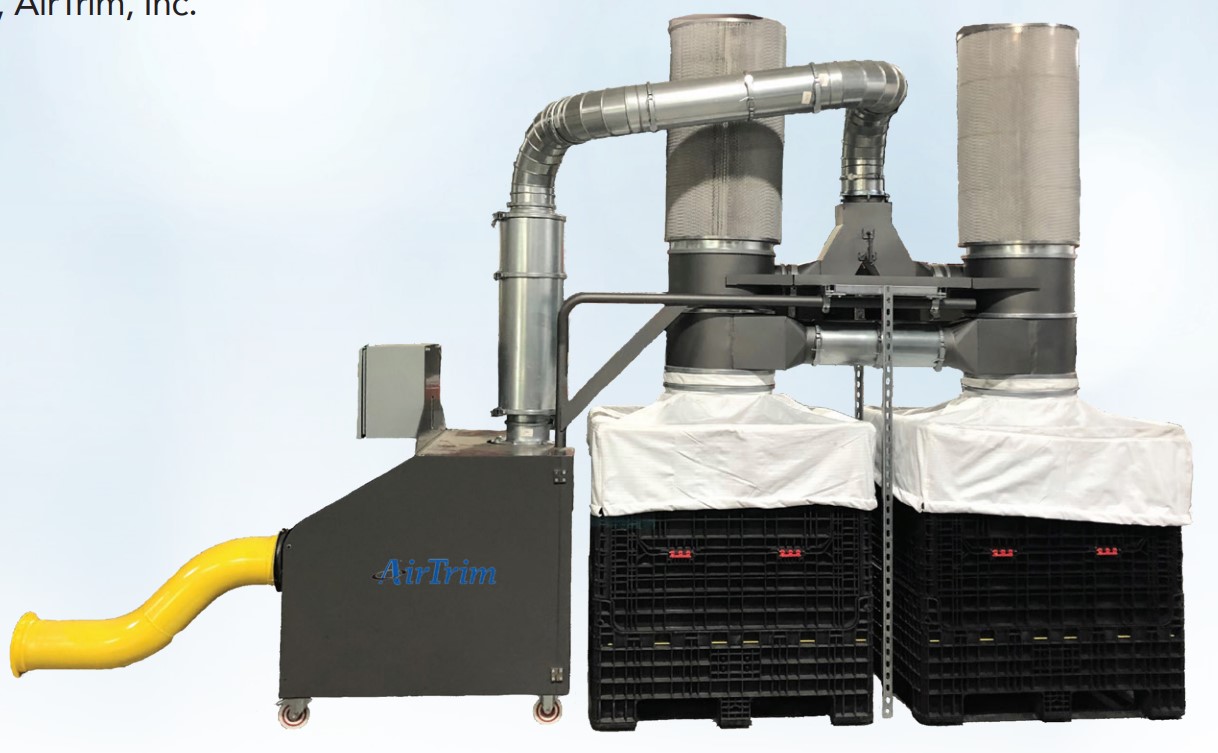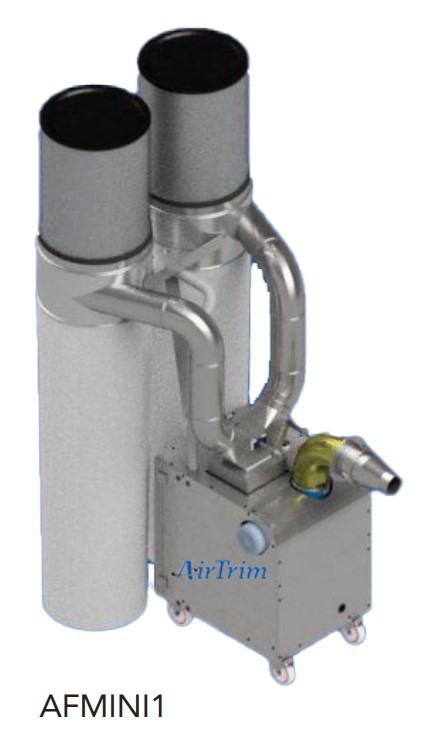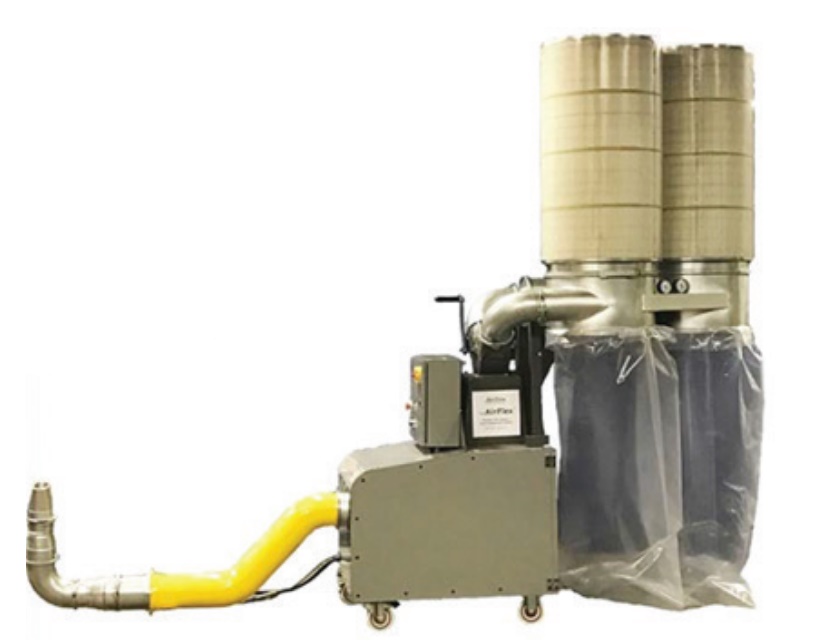Making a Case for Single Machine Trim Removal
- Published: January 30, 2023
By Robert DeHart, Engineering Manager, AirTrim, Inc.
No matter how you slice it, anytime you cut paper, foil or film, you create waste. Central collection systems for the collection of trim are often the ultimate objective for many facilities. These pneumatic systems have been around for years and offer many advantages. As a steppingstone to eventually installing a central system, the printing/converting industries have also relied on stationary, single machine trim waste removal systems. However, multiple improvements for single machine trim systems are providing printers/converters a choice between selecting central trim removal or single machine trim removal systems as a longer-term solution to trim removal systems.

Central Trim Removal vs. Single Machine Trim Removal System
When machine speeds produce a volume of trim waste too great for manual or forklift removal, companies have two pneumatic options to consider removing a higher volume of trim waste: central trim removal or single machine trim removal systems. Each approach has its advantages and disadvantages.
Central Trim Removal System
A CTRS is permanently installed, removes trim from multiple machines and conveys it to a waste collection point elsewhere in the facility (often towards the loading dock area). Material is conveyed via a system of intakes, round galvanized steel duct, through material handling fans or trim cutters. Waste is deposited into an air/material separator mounted above a baler or compactor.
CTRS’s are designed specifically for a particular converting/printing process and equipment locations. Each system is designed and custom built for this specific plant layout. Hence, they have long lead times, less production flexibility and a hefty price tag. Depending upon number of pieces of equipment in the system, central trim removal systems are normally priced much higher and have much longer shipment lead times than single machine trim removal systems.
Single Machine Trim Removal System
An SMTRS on the other hand, includes a self-contained collection device mounted as close to the printing/converting machine as possible. These are standard designs, produced in batches, with reflected pricing. Rather than conveying waste to a central collection point, SMTRS gather the waste into a bag/box close to the machine which must be monitored and emptied as required.
Choppers located within the single machine trim removal systems help to consolidate the waste stream so that more can be contained within the waste collection system. Price is certainly important, and SMTRS enjoy a clear advantage on this front. However, there are other aspects to consider when weighing collection system options.
Shipment Lead Time Urgency
With production deadlines ever-present, “How fast can I get this up and running?” is a common and important question for managers considering collection systems. Because CTRS are designed and manufactured specifically for a particular site, their lead times are typically measured in months rather than weeks.
Once on site, they require commissioning and employee training before they are functional. Pre-pandemic delivery schedules of 12-14 weeks were common; they may be markedly longer now. Standard SMTRS, on the other hand, are manufactured in batches rather than one-off, and depending upon current manufacturing back log they are often available with shorter lead times. Because they are essentially “plug and play,” portable units can be put into service upon delivery, yielding instant results.
 Trim Waste Volume
Trim Waste Volume
SMTRS typically employ through-the-fan systems for paper and trim cutters for plastic, film and foil systems to reduce the volume of waste generated. Reduced waste volumes translate into lower waste removal costs. CTRS follow this same tract and trim waste volume will be approximately the same for both types of systems.
Batch or Continuous Operations
Some SMTRS designs now feature dual waste collection and provide a second waste bin to permit manual diverting of waste flow to a second container without stopping the operation. The diverter directs the trim waste into the second container immediately after the first bag or container fills, allowing workers time to dispose of the first filled container.
This eliminates any production shutdowns due to waste removal on continuous operating lines. For batch operations there is a potential for using only one bag, but the second bag is available if needed. CTRS also accommodate both batch and continuous operations.
Portability
Some manufacturers of SMTRS have added portability to their systems. This allows them to be moved to highest value production runs where they will most easily benefit the company production schedules. Each printing/converting machine must have the same voltage to utilize the SMTRS portability feature.
CTRS are not portable, but rather fixed into one location; initial design of system will identify converting printing machines, material and processes for trim removal, both for existing and future equipment.
As more companies are recycling, the dual-bag SMTRS provides a method of separating recyclable material from non-recyclable material. With SMTRS, activating the manual diverter at material change separates the material into the correct category. CTRS deposit all trim waste (both the good and the bad) into the same separator, which prevents recovering the trim waste material eligible for recycling.
Accommodating Available Space
Converting/printing industry applications often work in a compact footprint where space comes at a premium. In these settings the available space plays a big role in the choice of waste collection system. Most facilities are already tight on space, so trying to shoehorn additional equipment into the mix may be a challenge.
The variety of sizes available and the self-contained design of SMTRS allow them to fit into the layout of existing facilities more easily. Their portability also plays a role here, allowing them to be moved should some component on the line require servicing or attention.
Depending upon the availability of plant space for a central trim removal system with larger components of fans, air/material separators and balers/compactors, CTRS may require more extensive redesign or may simply not be possible in some compact spaces.

Noise Level
SMTRS also keep the noise level down, which for some businesses is an important factor. According to OSHA, facilities operating at or above 85 decibels require ear plugs. SMTRS units often include silencers in their design to further reduce the noise level.
Some SMTRS operate below 80 decibels, so no hearing protection is required. CTRS, depending upon the selected location of fans needed in the system, by comparison may be louder and could cause facilities that have not used ear plugs before to start using them. Additional sound attenuation equipment may be required for central trim removal systems or locating the fans in an area of the plant without employees.
Summary
A variety of factors go into the purchase decision for the trim waste removal system in a printing/converting environment. For some businesses one or two dominant factors will be the driving force behind their decision. But for others that could utilize either a CTRS or SMTRS, they will need to identify what their waste removal goals are and see if they require a truly customized CTRS solution or if they are better served with a plug-and-play SMTRS. Given the price, lead-time and portability advantages of SMTRS, they are proving to be longer-term solutions to waste removal than just a few years ago. Whether selecting a Single or Central system, prospective purchasers are urged to prove out the suggested approach by sending samples to the vendor of choice to confirm that their offering achieves the desired objectives.
About the Author
As Engineering Manager, Robert DeHart assists AirTrim, Inc., a leader in designing, building and installing pneumatic material handling systems for U.S. and Canadian customers. AirTrim develops systems for a wide range of industries from converting, labeling, non-wovens and textiles, to paper and tissue mills, printing, packaging, pharmaceutical and medical, plastics, recycling and more. For additional information visit www.airtrim.com.












